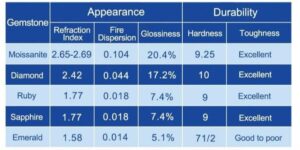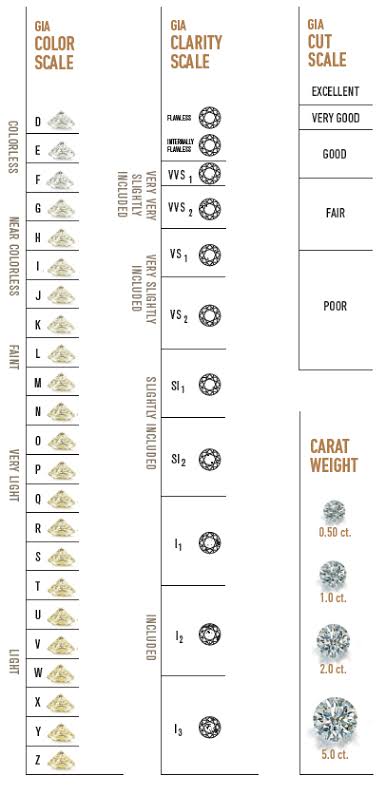What is Stardust gemstone (Moissanite)?
Here’s a diamond and a moissanite, can you guess which is which?
Simply put, moissanite is a rare and extremely brilliant gemstone that happens to resemble diamond…a lot! In fact, it’s the most brilliant gemstone ever to exist, and even beats diamond in brilliance, fire and beauty. Chemically, moissanite is a crystalline form of silicon carbide (SiC).
Why is moissanite called Stardust or Space-diamond?
Moissanite crystals, in nature, are formed in space, in the vicinity of some specific types of stars. This, and their exceptional resemblance to diamonds, earns them the nicknames Stardust and Space-diamond. On earth, natural moissanites are found only in trace quantities, usually in meteor impact craters. In fact, natural moissanite is the rarest gemstone on earth.
The birthplace of Moissanite
The jewel born of the stars, and perfected by science.
What’s the history behind moissanite?
Moissanite was discovered by the Nobel laureate French chemist Henri Moissan in 1893. The breakthrough was made in a meteor crater in Canyon Diablo, Arizona, USA, which is around 50,000 years old. Even Moissan took more than 10 years to realise that those crystals were not diamonds.
The 50,000 year old meteor crater in Arizona where moissanite was first discovered in 1893
In 1998, Charles & Colvard introduced moissanite to jewelry market. They also patented the marketing and creation process (in labs) of moissanite crystals. By 2018, all their worldwide patents had expired.
What is the current status of global moissanite jewelry market?
USA is currently the dominant market, with the size of approx $31 million in FY 2019-20. It is growing at a rapid pace of 7.7% annually, projected to reach $53 million by 2026. Europe is following the trend. On the other hand, there is a major lack of awareness about it in India.
How is moissanite different from diamond?
Moissanite has everything good about natural diamonds, and none of the negatives.
• It’s not mined, but made in laboratories, so there’s no harm to environment or humans. This is extremely important because natural diamonds are infamous for harming the environment and human rights (blood diamonds, anyone?).
Moissanite tops the chart in appearance, and comes second in durability.
This is just a glimpse into a small fraction of the damage that natural diamond industry does to our planet
• It has hardness and durability very close to diamond, and it doesn’t lose it’s shine or beauty over time. So much so that it’s also called ‘the new forever’ gemstone.
• It shines brilliantly, even more so than diamond. In fact, it is literally the MOST BRILLIANT gemstone.
• It, in its natural form, is the rarest gemstone on earth. In contrast, diamond is the most abundant gemstone.
• It is almost impossible to distinguish from a diamond, without specialized lab equipment. In fact, standard handheld diamond testers identify it as diamond.
A moissanite showing off it’s vastly superior dispersion and refractive properties as compared to a diamond.
– A standard handheld diamond tester identifying a moissanite gemstone as diamond
• It has an amazing story behind it’s discovery that also gives it a unique celestial connection and two cool nicknames : Stardust and Space-diamond. This has already been explained above.
• It is the only gemstone that has density lower than diamond, by approx 10%. Simply put, it means that 1 carat moissanite is significantly larger in size than 1 carat diamond.
• It is relatively affordable, especially for the most brilliant gemstone in the world. Here, we would like to emphasise… affordable, not ‘cheap’.
Moissanite is not just a diamond simulant or alternate gem, but the most brilliant gemstone in the world that happens to beat even diamond with its unmatched beauty and gorgeous fire.
What is the meaning of DEW?
DEW stands for Diamond Equivalent Weight. Moissanite weights are often expressed in DEW terms to give a better idea to the customers by comparing with diamond.
As mentioned above, moissanite is the only gemstone that has density lower than diamond, by approx 10%. This means that 1 carat (0.20gm) moissanite gemstone is larger than a diamond of the same weight.
On the other hand, a 0.88 carat moissanite gem has the same weight as 1 carat diamond. Hence a 0.88 carat moissanite is also said to be a 1 carat DEW moissanite. This factor further adds to the affordability and value for money proposition associated with moissanite with respect to diamond.
How is the quality of a moissanite gemstone evaluated?
Since moissanite resembles diamond, it’s qualitative evaluation is done using the same scale as that of diamond. The standard parameters, as defined by GIA (Gemological Institute of America), are
• Colour – The single most important aspect in moissanite quality is colour. DEF grade moissanite is the most sought after, as it is completely colourless (or transparent), and tough to create. All Kéana® Eco-diamonds moissanites fall in DEF colour grade.
• Clarity – Moissanite usually comes in very high clarity (usually VVS), simply because it’s created in labs, under controlled environment. All Kéana® Eco-diamonds moissanites have VVS1 clarity.
• Cut – The cut quality depends on the cutting and polishing precision. A well-cut gemstone maximizes the brilliance and fire. All Kéana® Eco-diamonds moissanites are cut at Very Good to Excellent grade.
• Carat – this is just a measure of weight of the gemstone. 1 carat = 0.20 gm. In diamonds, a bigger stone (higher carat stone) has higher per carat price. Moissanite also follows this trend, but the increase in the per carat price is not as steep as in case of diamond.
GIA quality chart for diamonds
Jewelry is like ice cream, there’s always room for more.
Please feel free to Contact Us if you have any questions about moissanites.
To start shopping with us, click the button below.



